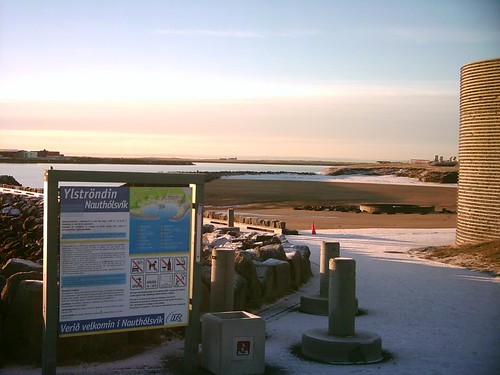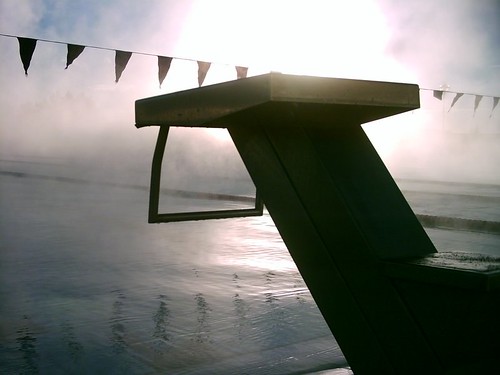Heitur pottur
There are really only two things in Iceland that are better in the winter than in the summer. One is the chance to see the Northern Lights, which obviously can't be combined with midnight sun. But 2005 is pretty much solar minimum -- that is, the quietest point of its ~11-year activity cycle -- so my odds were poor to begin with, and in any case cloudy December would still be the wrong month to pick for a trip to see aurorae. (My advice: wait until 2009 or 2010 and go someplace continental: perhaps Whitehorse or Yellowknife.)
That leaves the real reason to go to Iceland in the winter: the hot pools.
Iceland is a strange place. Geologically, it's a brand new land. It's the froth on the crest of a magma fountain, an exceptionally large mantle plume; simultaneously it is being torn raggedly in two on the fracture line between the European and American plates. Probably it is the most volcanic place on earth.
So hot water is pretty much free. You drill a well almost anywhere, pump cold water down, and it comes up boiling. In ReykjavÝk, it's a city utility: you connect up to both cold and hot water mains, and get it at 80 C (175 F) out of the taps. It smells rather sulfurous and will tarnish silver jewelry, but in a place where cheap hamburgers cost $15, I don't know if they even meter the hot water.
How cheap is it? Commercial farming operations grow vegetables in winter in greenhouses kept warm with geothermal steam. You drive into the valley at Hverageri and are met with clouds of warm fog glowing bright orange from the grow lights. They don't bother shuttering the glass -- insulation is more expensive than the heat. (Electricity is cheap, too. There are lots of places where you can get steam out of the ground hot enough to run straight in to a turbine. If they could think of more things to do with the electricity, they could generate a lot more of it. They already import aluminum ore from Australia for smelting.)
ReykjavÝk pipes warm water under city streets to keep them from freezing.
My guesthouse had a hot tub in the back. I don't know if they even had an insulating cover for it; as far as I could tell, they kept it warm all the time, uncovered in December, just by letting the water run.
It is so plentiful that ReykjavÝk creates for itself a warm-water beach by pouring millions of gallons of it into an artificial lagoon on the shores of the Greenland Sea. They call the place NauthˇlsvÝk Geothermal Beach, and it amounts to a city-sized hot tub. I was asking a guy in a bar about it, and he declared it the worst beach in the world: the sun is not hot enough, and the black volcanic sand is coarse. But he also said that on nice weekends the place is packed; I am unpersuaded that any place full of Icelandic girls in bikinis could be that bad.

Sadly, not even Icelanders are crazy enough to keep their beach open in December.
Every town in Iceland has a year-round outdoor swimming pool kept heated to 27 C (80 F). ReykjavÝk has seven of them, and the city is only 120,000 people. On a cold day, great clouds tower into the sky above the city, marking not power plants, but the locations of the city pools. They all have, in addition to the regular Olympic-sized swimming pool, a series of "hot pots", heitur pottur, containing water at a range of temperatures from soothing to searing.
Where other people would use cafes or pubs, Icelanders hang out and socialize in the hot tubs; they stay open until 9 or 10 at night. I was told that people would meet at the pool for office birthday parties and such. One I was in burst into Icelandic Christmas carolling; I was left awkwardly unable to join in.

The facilities are impressive. Sometimes there are shallow kiddie pools, or water slides, or steam rooms, sun lamps and spa facilities. Laugardalslaug is an athletic complex with stadium seating. ┴rbŠjarlaug has hiking trails. My favourite, Sundh÷llin, is an old-school downtown public bath hall where you rent towels from an attendant and get your own private locking changing booth. There are rows of these booths, filling the changing area like pigeon holes. The dividing walls and benches, everything but the wooden partition doors, are permanent construction, tiled in elegant seafoam green. You enter your changing room from one side and leave into the shower area through the other; the arrangement of halls is like nothing so much as arteries and veins.
Icelanders are conservative about wearing bathing suits in hot tubs, but strict about showering naked before entering. They use no chlorine in the pools, I presume because they constantly refresh the water with new from the hot mains, and so every pool shower room has large signs from the Board of Health announcing "ATHUGIđ! ATTENTION! ACHTUNG!" in six languages. There is a large outline of a person with the naughty bits helpfully highlighted and red arrows indicating that soap is to be applied. Shampoo is provided from sturdy gallon-sized pump dispensers on the walls.
At Sundh÷llin, the pool is in a hall indoors. When I was there, no one was using it. Everyone had gone upstairs and outside to the third-floor balcony for hot pots and a sauna, swirling steam, and a view over the roofs around us. I sank into the water and watched the mid-morning, pre-dawn sky slowly changing colours to the east.
I have also uploaded some new pictures from the trip, taken by Amy. Finally, this includes a picture of the 60-m Skogarfoss waterfall, and even one with me in it.
![[go to main index]](/notes/images/woodcut-sun-grey.jpg)


